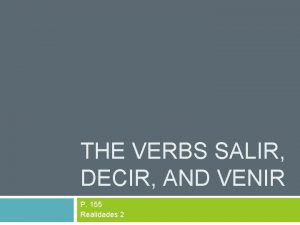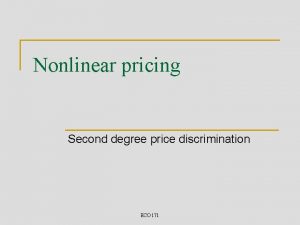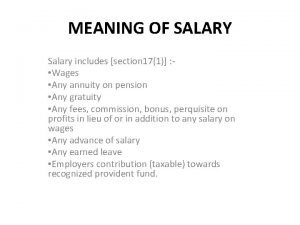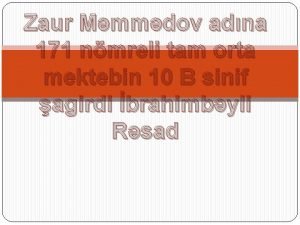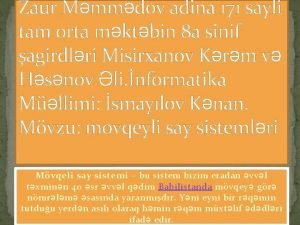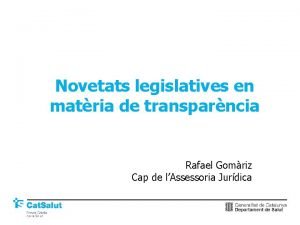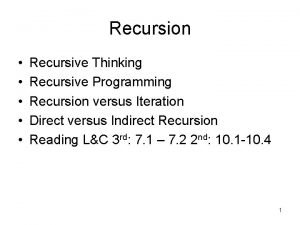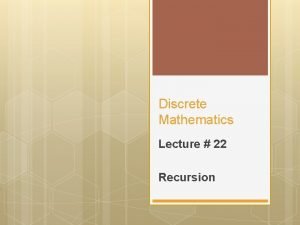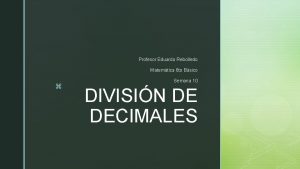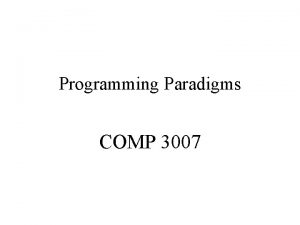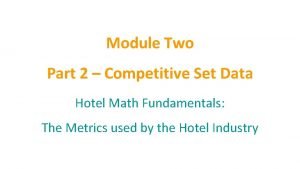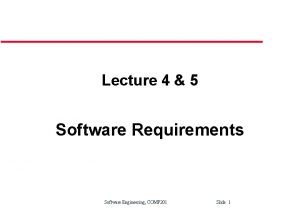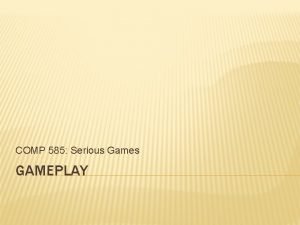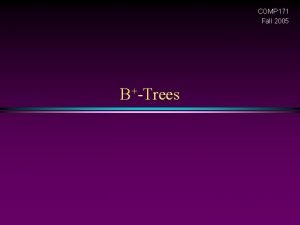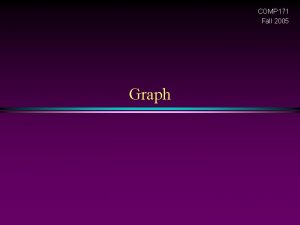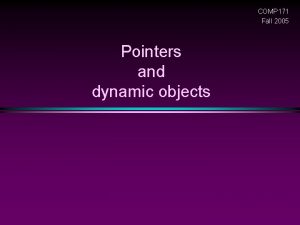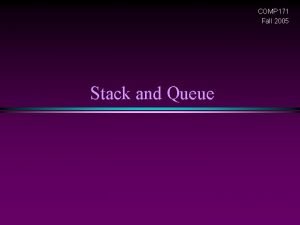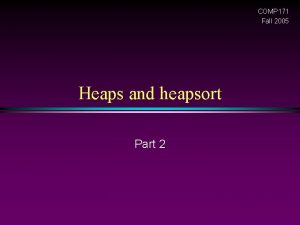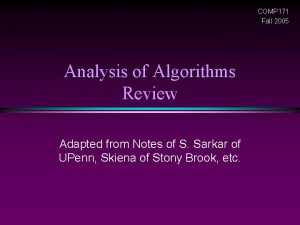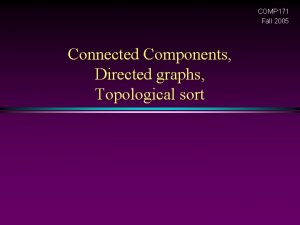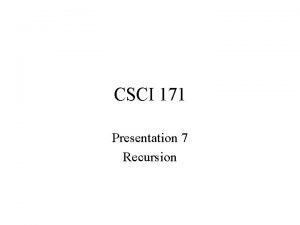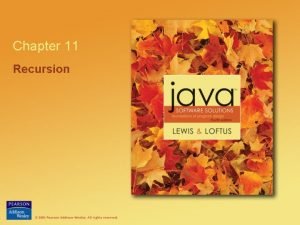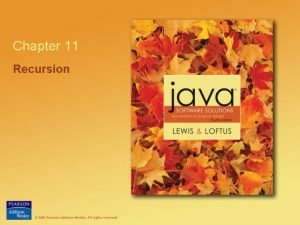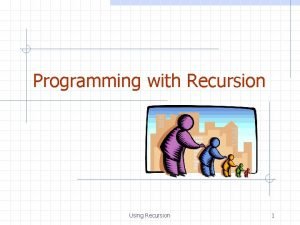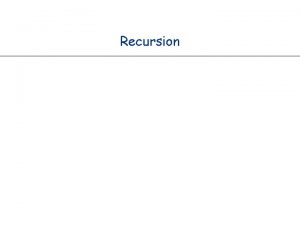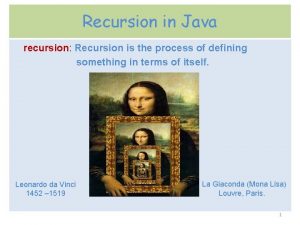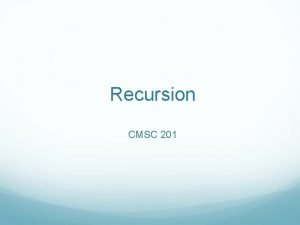COMP 171 Fall 2005 Math Recursion Recursion Slide









































- Slides: 41

COMP 171 Fall 2005 Math & Recursion

Recursion / Slide 2 Logarithms Definition: * Theorem 1. 1: * n * Proof: apply the definition Theorem 1. 2: log AB = log A + log B n * if and only if Proof: again apply the definition log A : default is base 2 n log 2 = 1, log 1 = 0, … • alog n = nlog a • log (a/b ) = log a - log b amn = (am )n = (an)m am+n = am an

Recursion / Slide 3 Mathematical Foundation • Series and summation: 1 + 2 + 3 + ……. N = N(N+1)/2 (arithmetic series) 1 + r+ r 2 + r 3 +………r. N-1 = (1 - r. N)/(1 -r), 1/(1 -r) , r < 1, large N • Sum of squares: 1 + 22 + 32 +………N 2 = N(N + 1)(2 N + 1)/6 (proof by induction) (geometric series)

Recursion / Slide 4 Proof By Induction • (2 n)0. 5 (n/e)n n (2 n)0. 5 (n/e)n + (1/12 n) • Prove that a property holds for input n= 1 (base case) • Assume that the property holds for input size 1, …n. Show that the property holds for input size n+1. • Then, the property holds for all input sizes, n. ?

Recursion / Slide 5 Try this: Prove that the sum of 1+2+…. . +n = n(n+1)/2 Proof: 1(1+1)/2 = 1 Thus the property holds for n = 1 (base case) Assume that the property holds for n=1, …, m, Thus 1 + 2 +…. . +m = m(m+1)/2 We will show that the property holds for n = m + 1, that is 1 + 2 + …. . + m + 1 = (m+1)(m+2)/2 This means that the property holds for n=2 since we have shown it for n=1 Again this means that the property holds for n=3 and then for n=4 and so on.

Recursion / Slide 6 Now we show that the property holds for n = m + 1, that is 1 + 2 + …. . + m + 1 = (m+1)(m+2)/2 assuming that 1 + 2 +…. . +m = m(m+1)/2 1 + 2 +…. . +m + (m+1) = m(m+1)/2 + (m+1) = (m+1)(m/2 + 1) = (m+1)(m+2)/2

Recursion / Slide 7 Sum of Squares Now we show that 1 + 22 + 32 +………n 2 = n(n + 1)(2 n + 1)/6 1(1+1)(2+1)/6 = 1 Thus the property holds for n = 1 (base case) Assume that the property holds for n=1, . . m, Thus 1 + 22 + 32 +………m 2 = m(m + 1)(2 m + 1)/6 and show the property for m + 1, that is show that 1 + 22 + 32 +………m 2 +(m+1)2 = (m+1)(m + 2)(2 m + 3)/6

Recursion / Slide 8 1 + 22 + 32 +………m 2 + (m+1)2 = m(m + 1)(2 m + 1)/6 + (m+1)2 =(m+1)[m(2 m+1)/6 +m+1] = (m+1)[2 m 2 + m + 6 m +6]/6 = (m+1)(m + 2)(2 m + 3)/6

Recursion / Slide 9 Fibonacci Numbers Sequence of numbers, F 0 F 1 , F 2 , F 3 , ……. F 0 = 1, F 1 = 1, Fi = Fi-1 + Fi-2 , F 2 = 2, F 3 = 3, F 4 = 5, F 5 = 8

Recursion / Slide 10 Prove that Fn+1 < (5/3)n+1 , F 2 < (5/3 )2 Let the property hold for 1, …k Thus Fk+1 < (5/3)k+1, Fk < (5/3)k Fk+2 = Fk + Fk+1 , < (5/3)k + (5/3)k+1 = (5/3)k (5/3 + 1) < (5/3)k (5/3)2

Recursion / Slide 11 Proof by Contradiction Want to prove something is not true! Give an example to show that it does not hold! Is FN N 2 ? No, F 11 = 144 However, if you were to show that FN N 2 then you need to show for all N, and not just one number.

Recursion / Slide 12 Proof by Contradiction Suppose, you want to prove something. Assume that what you want to prove does not hold. Then show that you arrive at an impossibility. Example: The number of prime numbers is not finite!

Recursion / Slide 13 Suppose the number of primes is finite, k. The primes are P 1, P 2…. . Pk The largest prime is Pk Consider the number N = 1 + P 1, P 2…. . Pk N is larger than Pk Thus N is not prime. So N must be product of some primes. However, none of the primes P 1, P 2…. . Pk divide N exactly. So N is not a product of primes. (contradiction)

Recursion / Slide 14 Recursion * In some problems, it may be natural to define the problem in terms of the problem itself. * Recursion is useful for problems that can be represented by a simpler version of the same problem. * Example: the factorial function 6! = 6 * 5 * 4 * 3 * 2 * 1 We could write: 6! = 6 * 5!

Recursion / Slide 15 Example 1: factorial function In general, we can express the factorial function as follows: n! = n * (n-1)! Is this correct? Well… almost. The factorial function is only defined for positive integers. So we should be a bit more precise: n! = 1 n! = n * (n-1)! (if n is equal to 1) (if n is larger than 1)

Recursion / Slide 16 factorial function The C++ equivalent of this definition: int fac(int numb){ if(numb<=1) return 1; else return numb * fac(numb-1); } recursion means that a function calls itself

Recursion / Slide 17 factorial function * Assume the number typed is 3, that is, numb=3. fac(3) : 3 <= 1 ? No. fac(3) = 3 * fac(2) : 2 <= 1 ? No. fac(2) = 2 * fac(1) : 1 <= 1 ? Yes. return 1 int fac(int numb){ fac(2) = 2 * 1 = 2 if(numb<=1) return fac(2) return 1; else fac(3) = 3 * 2 = 6 return numb * fac(numb-1); return fac(3) } fac(3) has the value 6

Recursion / Slide 18 factorial function For certain problems (such as the factorial function), a recursive solution often leads to short and elegant code. Compare the recursive solution with the iterative solution: Recursive solution Iterative solution int fac(int numb){ if(numb<=1) int product=1; return 1; while(numb>1){ else product *= numb; return numb*fac(numb-1); numb--; } } return product; }

Recursion / Slide 19 Recursion To trace recursion, recall that function calls operate as a stack – the new function is put on top of the caller We have to pay a price for recursion: calling a function consumes more time and memory than adjusting a loop counter. n high performance applications (graphic action games, simulations of nuclear explosions) hardly ever use recursion. n In less demanding applications recursion is an attractive alternative for iteration (for the right problems!)

Recursion / Slide 20 Recursion If we use iteration, we must be careful not to create an infinite loop by accident: for(int incr=1; incr!=10; incr+=2). . . Oops! int result = 1; while(result >0){. . . result++; } Oops!

Recursion / Slide 21 Recursion Similarly, if we use recursion we must be careful not to create an infinite chain of function calls: int fac(int numb){ return numb * fac(numb-1); } Or: Oops! No termination condition int fac(int numb){ if (numb<=1) return 1; else return numb * fac(numb+1); } Oops!

Recursion / Slide 22 Recursion We must always make sure that the recursion bottoms out: *A recursive function must contain at least one non-recursive branch. * The recursive calls must eventually lead to a non-recursive branch.

Recursion / Slide 23 Recursion * Recursion is one way to decompose a task into smaller subtasks. At least one of the subtasks is a smaller example of the same task. * The smallest example of the same task has a non-recursive solution. Example: The factorial function n! = n * (n-1)! and 1! = 1

Recursion / Slide 24 Example 2: Fibonacci numbers *Fibonacci numbers: 0, 1, 1, 2, 3, 5, 8, 13, 21, 34, . . . where each number is the sum of the preceding two. * Recursive definition: F(0) = 0; n F(1) = 1; n F(number) = F(number-1)+ F(number-2); n

Recursion / Slide 25

Recursion / Slide 26 Example 3: Fibonacci numbers //Calculate Fibonacci numbers using recursive function. //A very inefficient way, but illustrates recursion well int fib(int number) { if (number == 0) return 0; if (number == 1) return 1; return (fib(number-1) + fib(number-2)); } int main(){ // driver function int inp_number; cout << "Please enter an integer: "; cin >> inp_number; cout << "The Fibonacci number for "<< inp_number << " is "<< fib(inp_number)<<endl; return 0; }

Recursion / Slide 27 Copyright © 2000 by Brooks/Cole Publishing Company A division of International Thomson Publishing Inc.

Recursion / Slide 28 Trace a Fibonacci Number * Assume the input number is 4, that is, num=4: fib(4): 4 == 0 ? No; 4 == 1? No. fib(4) = fib(3) + fib(2) fib(3): 3 == 0 ? No; 3 == 1? No. fib(3) = fib(2) + fib(1) fib(2): 2 == 0? No; 2==1? No. fib(2) = fib(1)+fib(0) fib(1): 1== 0 ? No; 1 == 1? Yes. fib(1) = 1; return fib(1); int fib(int num) { if (num == 0) return 0; if (num == 1) return 1; return (fib(num-1)+fib(num-2)); }

Recursion / Slide 29 Trace a Fibonacci Number fib(0): 0 == 0 ? Yes. fib(0) = 0; return fib(0); fib(2) = 1 + 0 = 1; return fib(2); fib(3) = 1 + fib(1): 1 == 0 ? No; 1 == 1? Yes fib(1) = 1; return fib(1); fib(3) = 1 + 1 = 2; return fib(3)

Recursion / Slide 30 Trace a Fibonacci Number fib(2): 2 == 0 ? No; 2 == 1? No. fib(2) = fib(1) + fib(0) fib(1): 1== 0 ? No; 1 == 1? Yes. fib(1) = 1; return fib(1); fib(0): 0 == 0 ? Yes. fib(0) = 0; return fib(0); fib(2) = 1 + 0 = 1; return fib(2); fib(4) = fib(3) + fib(2) = 2 + 1 = 3; return fib(4);

Recursion / Slide 31 Fibonacci number w/o recursion //Calculate Fibonacci numbers iteratively //much more efficient than recursive solution int fib(int n) { int f[n+1]; f[0] = 0; f[1] = 1; for (int i=2; i<= n; i++) f[i] = f[i-1] + f[i-2]; return f[n]; }

Recursion / Slide 32 Example 3: Binary Search n Search for an element in an array 1 Sequential search 1 Binary search n Binary search 1 Compare the search element with the middle element of the array 1 If not equal, then apply binary search to half of the array (if not empty) where the search element would be.

Recursion / Slide 33 Binary Search with Recursion // Searches an ordered array of integers using recursion int bsearchr(const int data[], // input: array int first, // input: lower bound int last, // input: upper bound int value // input: value to find )// output: index if found, otherwise return – 1 { } int middle = (first + last) / 2; if (data[middle] == value) return middle; else if (first >= last) return -1; else if (value < data[middle]) return bsearchr(data, first, middle-1, value); else return bsearchr(data, middle+1, last, value);

Recursion / Slide 34 Binary Search int main() { const int array_size = 8; int list[array_size]={1, 2, 3, 5, 7, 10, 14, 17}; int search_value; cout << "Enter search value: "; cin >> search_value; cout << bsearchr(list, 0, array_size-1, search_value) << endl; return 0; }

Recursion / Slide 35 Binary Search w/o recursion // Searches an ordered array of integers int bsearch(const int data[], // input: array int size, // input: array size int value // input: value to find ){ // output: if found, return // index; otherwise, return -1 int first, last, upper; first = 0; last = size - 1; while (true) { middle = (first + last) / 2; if (data[middle] == value) return middle; else if (first >= last) return -1; else if (value < data[middle]) last = middle - 1; else first = middle + 1; } }

Recursion / Slide 36 Recursion General Form * How to write recursively? int recur_fn(parameters){ if(stopping condition) return stopping value; // other stopping conditions if needed return function of recur_fn(revised parameters) }

Recursion / Slide 37 Example 4: exponential func * How to write exp(int numb, int power) recursively? int exp(int numb, int power){ if(power ==0) return 1; return numb * exp(numb, power -1); }

Recursion / Slide 38 Example 5: number of zero Write a recursive function that counts the number of zero digits in an integer * zeros(10200) returns 3. * int zeros(int numb){ if(numb==0) // 1 digit (zero/non-zero): return 1; // bottom out. else if(numb < 10 && numb > -10) return 0; else // > 1 digits: recursion return zeros(numb/10) + zeros(numb%10); } zeros(10200) zeros(1020) + zeros(0) zeros(102) + zeros(0) zeros(10) + zeros(2) + zeros(0) zeros(1) + zeros(0) + zeros(2) + zeros(0)

Recursion / Slide 39 Example 6: Towers of Hanoi n Only one disc could be moved at a time n A larger disc must never be stacked above a smaller one n One and only one extra needle could be used for intermediate storage of discs

Recursion / Slide 40 Towers of Hanoi void hanoi(int from, int to, int num) { int temp = 6 - from - to; //find the temporary //storage column if (num == 1){ cout << "move disc 1 from " << from << " to " << to << endl; } else { hanoi(from, temp, num - 1); cout << "move disc " << num << " from " << from << " to " << to << endl; hanoi(temp, to, num - 1); } }

Recursion / Slide 41 Towers of Hanoi int main() { int num_disc; //number of discs cout << "Please enter a positive number (0 to quit)"; cin >> num_disc; while (num_disc > 0){ hanoi(1, 3, num_disc); cout << "Please enter a positive number "; cin >> num_disc; } return 0; }
 Heel and toe polka
Heel and toe polka To understand recursion you must understand recursion
To understand recursion you must understand recursion Pg 171
Pg 171 29052007
29052007 The verbs salir decir and venir p.155
The verbs salir decir and venir p.155 171
171 Ai 171
Ai 171 Ai 171
Ai 171 Meaning
Meaning Informasiya prosesleri
Informasiya prosesleri 171 nomreli mekteb
171 nomreli mekteb Decret 171/2015
Decret 171/2015 Dot
Dot Cs 171 uci
Cs 171 uci 171 in binary
171 in binary 171 nomreli mekteb
171 nomreli mekteb 171 sayli mekteb
171 sayli mekteb Recursion in math
Recursion in math What is recursion in discrete mathematics
What is recursion in discrete mathematics Factoring polynomials
Factoring polynomials Eduardo rebolledo
Eduardo rebolledo Google slide math
Google slide math Ppt
Ppt Sharing
Sharing Topmarks
Topmarks Doterra income disclosure
Doterra income disclosure Comp tox
Comp tox Apcs recursion
Apcs recursion Comp 3007
Comp 3007 Hotel comp set performance data
Hotel comp set performance data Hotel comp set benchmarking
Hotel comp set benchmarking Dairy comp 305
Dairy comp 305 Comp.os.minix
Comp.os.minix What is domain requirements in software engineering
What is domain requirements in software engineering Im comp plan
Im comp plan Actroid
Actroid Kidbiz 300
Kidbiz 300 Eecs 110
Eecs 110 Comp 410 unc
Comp 410 unc Comp sci 1102
Comp sci 1102 Comp 6321
Comp 6321 Comp 585
Comp 585




